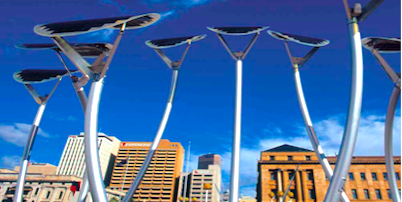Energiewende: Eine 1,2-Millionen-Stadt macht’s vor
Adelaide, die Hauptstadt von South Australia, ist die fünftgrösste Stadt des Kontinents. Im Jahr 2003 verfasste der damals 60-jährige Stadt-Ökologe und Umweltaktivist Herbert Girardet vor Ort den Report «Creating a Sustainable Adelaide», der 32 konkrete Vorschläge enthielt, welche die Regierung Australiens in wesentlichen Teilen zu realisieren begann.
Während in der Schweiz der Stromverbrauch von Haushalten und Unternehmen sogar noch mit Mengenrabatten gefördert wird und über eine Energiewende viel geredet aber wenig unternommen wird, kann die australische Millionenstadt Adelaide nach neun Jahren entschlossenem Handeln mit Stolz folgende Zahlen präsentieren:
- 26 Prozent des Stroms wird mit Solarzellen und Windenergie produziert. Fast alle öffentliche Gebäude sowie auf 600’000 Häusern sind Solarzellen installiert.
- Der Staat geht mit dem guten Beispiel voran: Die öffentlichen Gebäude haben ihren CO2-Ausstoss auf 40 Prozent gesenkt. Die ganze Stadt hat ihren CO2-Ausstoss seit 2000 trotz Wachstums um 15 Prozent gesenkt.
- Auf 2000 Hektaren wurden drei Millionen Bäume gepflanzt, um die Biodiversität zu erhöhen und um CO2 zu absorbieren.
- Produktion von 180’000 Tonnen Kompost aus städtischen organischen Abfällen. Der Kompost wird u.a. verwendet, um 20’000 Hektaren Land am Rand der Stadt in Gemüse- und Früchtefelder zu verwandeln. Auch brauchbares Abwasser kam zum Einsatz.
Herbert Girardet beschreibt diese Erfolgsgeschichte in der neusten Ausgabe von «Resurgence & Ecologist». Im Folgenden einige Auszüge:
Three-quarters of us already live in cities
By and large, the consumption patterns of people living in urban or in rural areas are very similar in the rich countries. But what about rapidly urbanising developing countries? Studies from China and India have shown that people moving from a village to a city will, typically, increase their resource consumption fourfold. The reason is quite evident: traditional rural living relies largely on renewable local resources. In cities it is much easier for people to get access to fossil fuels and to become involved in a consumer lifestyle than in the village back home. A farmer who becomes an urban factory worker will inevitably become tied in with a lifestyle dependent on mineral resources, and as hundreds of millions of people adopt an urban way of life this has huge consequences for the future of our home planet…In Europe, America and Australia over three-quarters of us already live in cities.
If all people on Earth lived the lifestyles we lead in European cities, three planets would be needed. Since we only have one planet available to us, we’d better change the way we live. Can we design and run our cities in better ways?
The Adelaide experience
In 2003 I was invited by the premier of South Australia, Mike Rann, to be Adelaide’s inaugural Thinker in Residence, focusing on the ‘greening’ of metropolitan Adelaide. The working premise I defined for my residency was quite simple: active moves towards environmental sustainability could be an excellent basis for creating new businesses and jobs by internalising and reducing resource flows. The reasons for this are quite simple: a city region that takes active measures to improve the efficiency of its use of resources also reduces its reliance on imported resources – it relocalises parts of its energy and food economy and brings a substantial part back home.
During a nine-week period, my colleagues and I invited a wide cross-section of people to discuss ways in which metropolitan Adelaide could benefit from becoming a sustainable city region. In every seminar we brought together people who had similar aims but often had never met before. At the end of my residency I published a report called Creating a Sustainable Adelaide, with 32 recommendations that were subsequently scrutinised by a South Australian cabinet committee and became the basis for many new policy initiatives.
In Adelaide, a decade ago, concern about uncertain water supplies and the threat of droughts had started to stimulate a wider discussion about the need for sustainable redevelopment. Since then, the tangible effects of climate change, and Greater Adelaide’s role in causing it, have been cited as an urgent reason for drawing up an overarching integrated urban systems design strategy, and a targeted programme for implementing this.
A new green economy
In November 2011 I went back to Adelaide to find out what had happened there regarding my proposals. It soon became apparent that the government of South Australia and Adelaide City Council had taken many truly remarkable initiatives in the previous nine years. I think Adelaide is well on its way to becoming not just a sustainable city but a regenerative city: it has been building a new green economy while actively contributing to the wellbeing and restoration of ecosystems and soils in South Australia.
An impressive start
Creating sustainable and environmentally regenerative cities is a challenge that very few urban communities, politicians, administrators and educators have had to deal with. Greater Adelaide has made an impressive start that is of relevance to cities all over the world: it has developed many of the attributes of a regenerative city – large-scale waste recycling, waste-water crop irrigation, organic waste composting, peri- urban agriculture, tree planting, biodiversity protection, energy efficiency initiatives and renewable energy development. It is an excellent start but a lot more still needs to be done.
Themenbezogene Interessenbindung der Autorin/des Autors
Herbert Girardet advises city and national governments on regenerative development strategies. He is the author and co-author of 50 TV documentaries and 12 books.










Für wie dumm hält uns der Autor eigentlich?
Was den Wahrheitsgehalt des Artikels anbetrifft, so können schon die Zahlen nicht stimmen:
1. Wenn – neben den öffentlichen Gebäuden – in einer Stadt mit 1,2 Millionen Einwohnern auf 600’000 Häusern Solarzellen installiert wären, dann würden im Durchschnitt pro Haus nur 2 Personen wohnen. Auch wenn es in Australien prozentual mehr Einfamilienhäuser gibt als hier, diese DURCHSCHNITTSZAHL ist unglaubwürdig und würde zudem voraussetzen, dass SÄMTLICHE Häuser der Stadt mit Solarzellen ausgerüstet sind. Das dürfte unrealis-tisch sein.
2. Wenn auf 2000 Hektaren 3 Millionen Bäume Platz haben sollen, dann müssen die Bäume in einem Abstand von gerade einmal 2,58 Metern voneinander gepflanzt. Das sind aber kleine Bäume!
3. Dass eine vierköpfige Familie pro Jahr – neben allen nichtorganischen Abfällen wie Papier, Plastik, Verpackungen usw. – 600 Kilo rein organische Abfälle produziert, wäre ein unrühmlicher Rekord an Verschwendung von Gemüse und Früchten.
4. Mit dem daraus produzierten Kompost sollen 200 Quadratkilometer (!) Gemüse und Fruchtfelder gedüngt werden. Das ist knapp zweieinhalb mal die Fläche des Zürichsees und dafür reicht auch der Kompost einer Millionenstadt nicht für eine Düngung aus.
Fazit: Unwahrscheinliche Daten. Darum vor dem Schreiben Hirn einschalten.